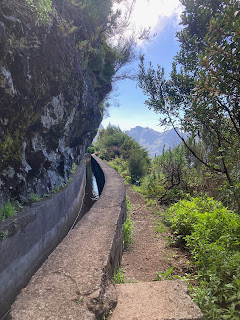Breathtaking Levada Nature Walk in Madeira
Breathtaking Levada Nature Walk in Madeira
Levada nature walk in Ecumeada, Madeira
Today we did a half-day Levada hike along PR 1.3 Vereda da Encumeada that takes you through the heart of Madeira Island where you get to experience first-hand the breathtaking natural beauty of this sub-tropical island.
Along this route we have passed two very different ecosystems, the Central Mountainous Massif (with its predominant volcanic escarpment) and the Laurisilva Forest (with its vibrant green forest characterized by herbaceous and bush vegetation including Erica scoparia ssp maderensis and Erica aborea, both well-adapted to large temperature variations, heavy rains and strong winds and abundant with wildflowers)
Laurissilva forest species found at this altitude urzal above 1400m include Til or stinkwood (Ocotea foetens), Loureiro laurel (Laurus novocanariensis), Lily-of-the-valley tree (Clethra arborea), Sanguinho-da-madeira (Rhamnus glandulosa), Pride of Madeira (Echium candivcans) that grow as 1 to 2-meter-high candelabra-like shrubs with purplish-blue inflorescences that blossom terminally on side shoots, the very rare Madeira Orchid (Dactylorhiza foliosa) with spikes of intense, magenta-pink flowers, bright yellow sprigs of Madeira broom (Genista tenera) and Mandon (Argyranthemum pinnatifidum) with its deeply serrated leaves and relatively large white daisy-like flowers with a yellow centre.
Apparently, there are also caves (furnas) dug out of the rocks, such as Furna da Lapa da Cadela. These were places of shelter for those who, in former times, walked along Vereda da Encumeada with the mission of cutting heather (Madeira broom heather - Erica platycodon subsp. maderincola and Molar heather - Erica arborea) for piling, firewood or charcoal production.
With the proximity of Encumeada the feeling of being in the centre of the island increases, as you can admire the panoramic view over the majestic valleys of Curral das Freiras, landscapes South (Serra D’Água) as the valley of São Vicente to the north.
Levadas of Madeira
The “levadas” are channels of water with a gentle slope originally created to transport the water of the north of the Island, with a humid climate and more precipitation, to the south where the climate is drier, with more population and plantations.
The Levadas (from the Portuguese verb “levar” – to carry) of Madeira are a system of channels or aqueducts 1300 kilometres in length, mostly bordering mountains but also going through them, with several stretches over rugged rocks, to bring water via aqueducts from different sources in the north where precipitation is much higher to its intermediate or final uses including sugar cane and banana plantations in the south where there is more agriculture and people.
The Levadas (from the Portuguese verb “levar” – to carry) of Madeira are a system of channels or aqueducts 1300 kilometres in length, mostly bordering mountains but also going through them, with several stretches over rugged rocks, to bring water via aqueducts from different sources in the north where precipitation is much higher to its intermediate or final uses including sugar cane and banana plantations in the south where there is more agriculture and people.
Along the way, you will also find several tunnels that carry the water from the north side of the mountains to the south side.
Besides sugar cane, the levadas were also very important in irrigating the vineyard plantations that gave origin to the emblematic and well-known Madeira Wine.
The origin of the levadas dates back to the first settlements of Madeira Island, in the first quarter of the 15th century, when water became necessary to water farmlands, particularly sugar cane fields – the first crop of high economic value in Madeira – and for the functioning of the first mills and sugar aka white gold factories. It is worth noting that in the second half of the 15th century, water carried by levadas was essential to Madeira Island’s becoming one of the largest producers and exporters of sugar in Europe, the “World” of those days.
According to the chronicles of the time, the first levadas were rudimentary waterways, short and dug out in the volcanic tufts. When the rock was so hard that the levada frame could not be dug, segments built out of wood from endemic species such as Madeira laurel (Ocotea foetens) or Canary laurel (Appollonias barbujana) would be used in the shape of a gutter.
The early gave place to waterways built in basalt rock masonry, some of them being basalt cobblestone aqueducts. The most common cross sections were under one metre in width and the depth varied between fifty and seventy centimetres.
The water flow through the network of levadas is controlled by manual sluice gates
Debris and fallen leaves are collected at intermittent points to keep the water clean and free-flowing in the levadas.
With the ongoing expansion of farming operations, first with the cultivation of sugar cane, then later with winegrowing, and nowadays with the cultivation of bananas, the levadas network kept growing all over the island and its construction demanded more advanced techniques.
Nowadays, the Levada walks are also a great way to explore and discover the magnificent nature of Madeira Island, with landscapes and species of flora and fauna that are unique in the world.
References
- What is a Levada? (n.d.). WalkMe Levadas Madeira. Retrieved May 12, 2024, from https://walkmeguide.com/en/what-is-a-levada/
- PR 1.3 - Vereda da Encumeada - Visit Madeira. (n.d.). Madeira Islands Tourism Board. Retrieved May 12, 2024, from https://visitmadeira.com/en/what-to-do/nature-seekers/activities/hiking/pr-13-vereda-da-encumeada/
- Madeira Islands - walking Guide. (n.d.). Director of Tourism, Madeira. Retrieved May 12, 2024, from http://www.helloguidemadeira.com/images/maps-pdf/madeira-levadas-map-en.pdf












Wonderfully written about one of God's wonders
ReplyDelete